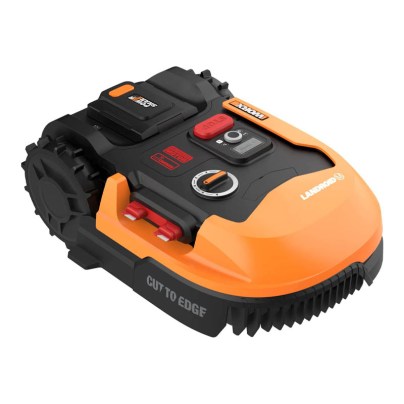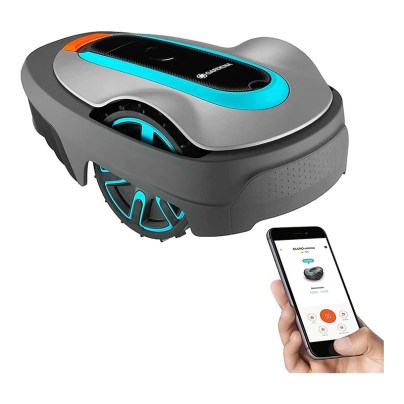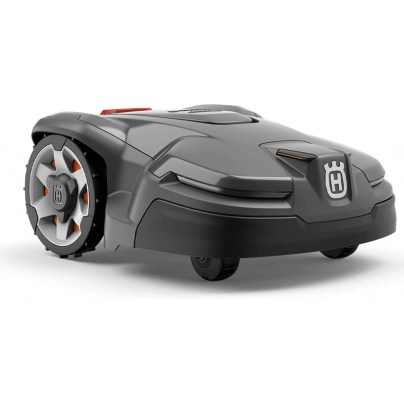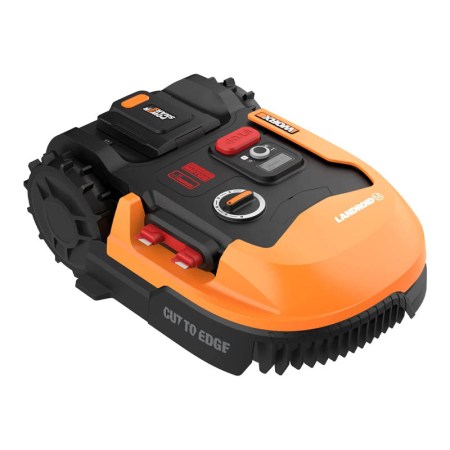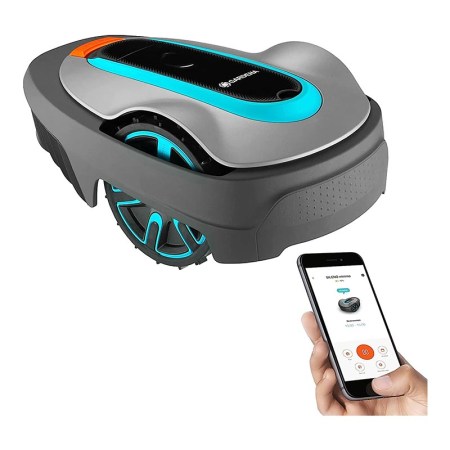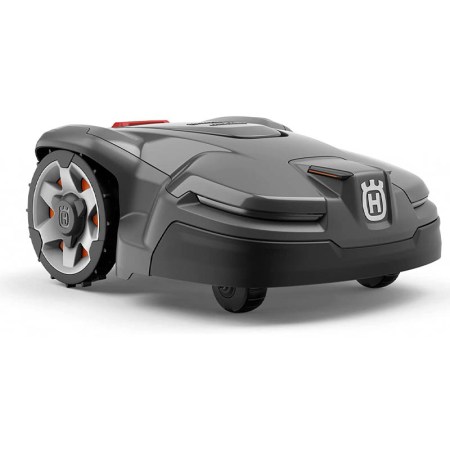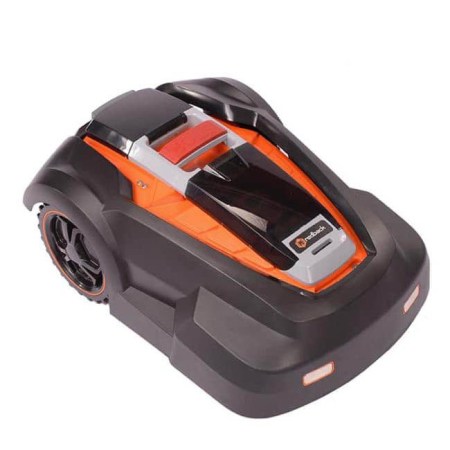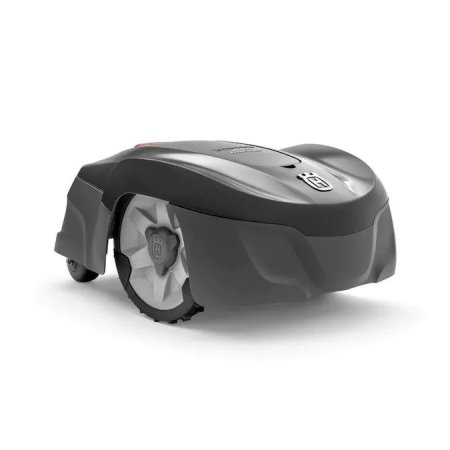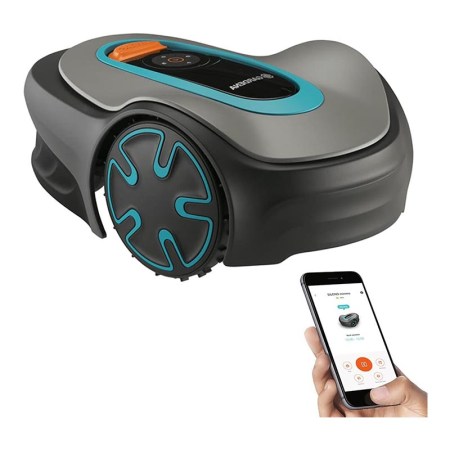We may earn revenue from the products available on this page and participate in affiliate programs. Learn More ›
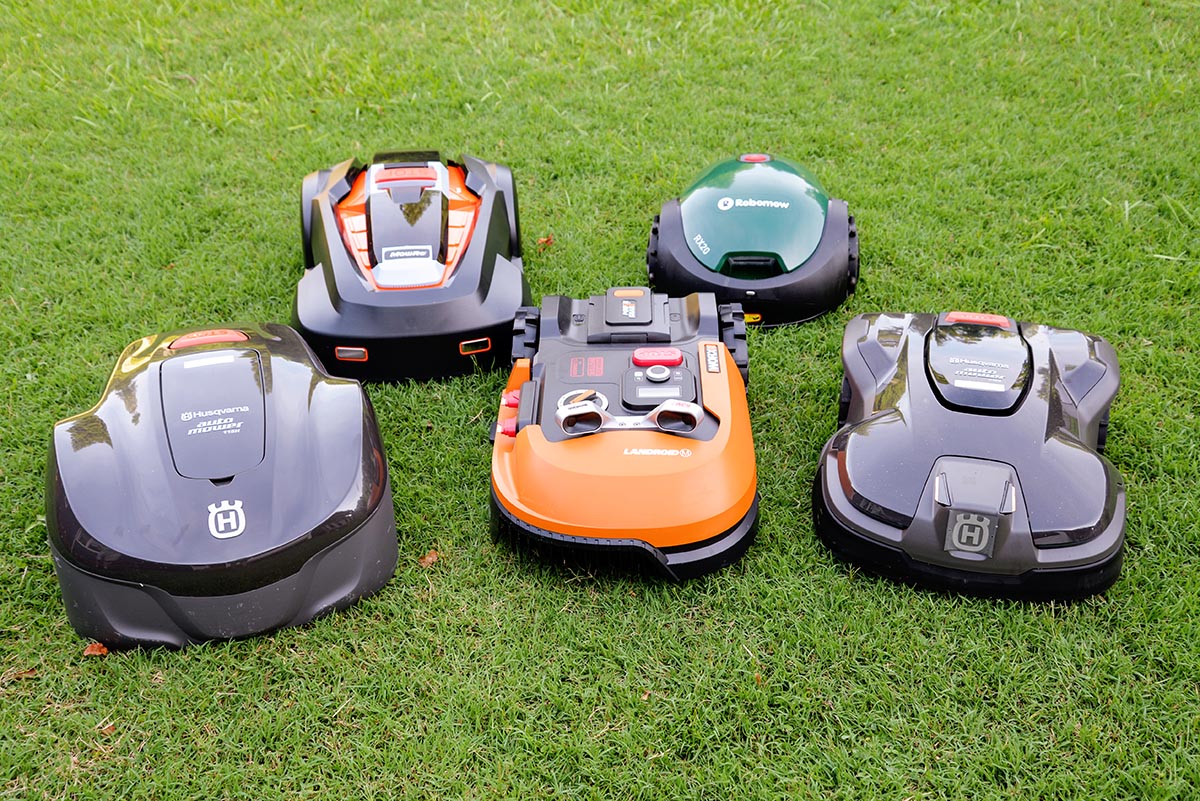
Improvements in rechargeable battery tech and intelligent software have dramatically changed the way we live. Smart televisions and lighting systems improve our sensory environment, while other automated home devices like vacuum cleaners, thermostats, and refrigerators minimize many more mundane tasks. Similarly, robotic lawn mowers can now keep the grass at just the right height, eliminating a time-consuming weekend chore.
These devices may even cost less to own and operate than gasoline-powered mowers while making very little noise and producing no exhaust emissions. They maintain up to an acre or more on most types of terrain, and they work automatically so folks with lawns have more time to relax and enjoy their green space.
No doubt, all of this sounds great—but how well do these robots actually perform? To find out, we put some popular models through their paces on real-life lawns. Read on to learn about the criteria we used to select these mowers, and then check out our product reviews to find out how each one did on our test turf. Anyone in the market for a new mower might just discover that a robot model can be a smart, time-saving investment. R2-D2 would surely approve!
- BEST OVERALL: Worx Landroid M 20V Robotic Lawn Mower
- BEST BANG FOR THE BUCK: Gardena 15001-20 Sileno City Automatic Robotic Mower
- UPGRADE PICK: Husqvarna Automower 415X Robotic Lawn Mower
- BEST FOR STEEP HILLS: Redback MowRo 9.5-Inch Robot Lawn Mower
- BEST FOR LARGE LAWNS: Husqvarna Automower 115H Robotic Lawn Mower
- BEST FOR SMALL LAWNS: Gardena 15202-41 Sileno Minimo Robotic Mower
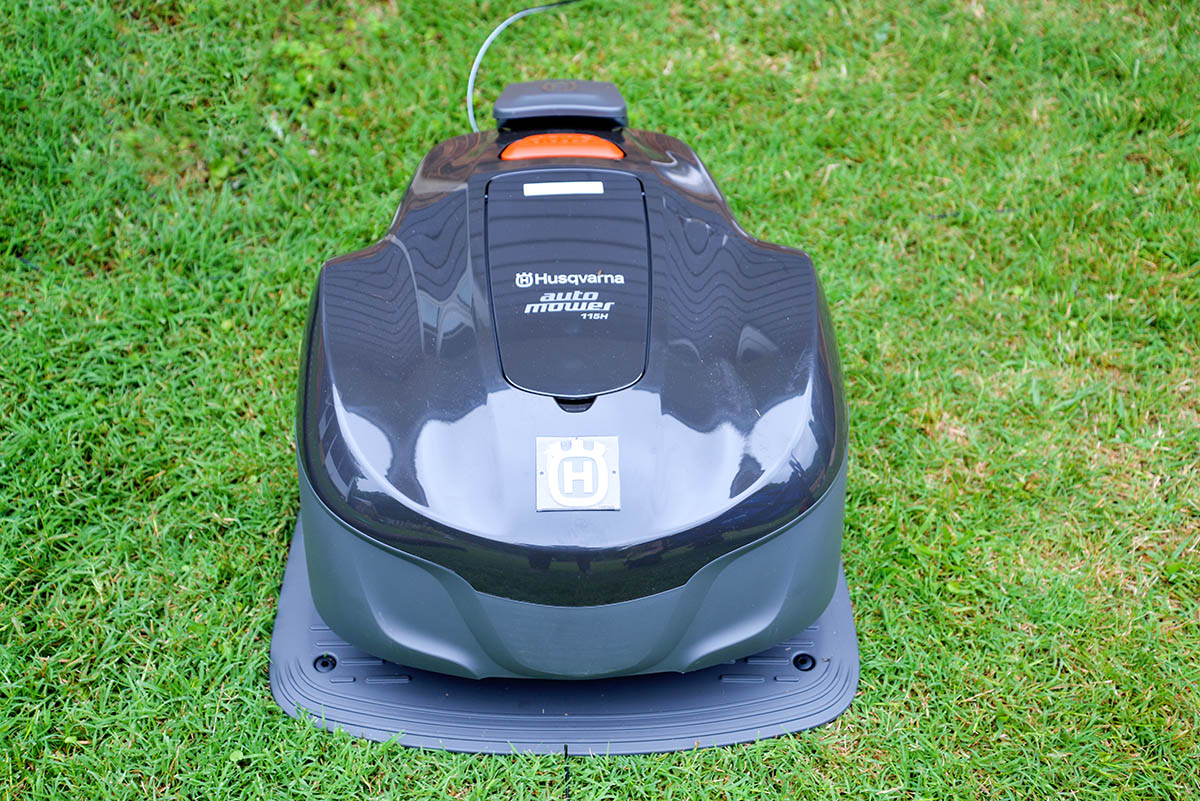
How We Tested the Best Robotic Lawn Mowers
We wanted some expert advice, so we interviewed Kody J. Ketterling, the founder of K-IT Products, a lawn care company based in Twin Falls, Idaho. His advice to shoppers is to make sure that the mower can maintain and keep up with the property you’re working to service. “Steep hills, narrow areas, lots of yard separations, and rough or bumpy ground can make it more difficult for a robot lawn mower to do its job,” he says.
With this expert advice in mind, we got our hands on some robot mowers. All of the models we tested use 14-gauge low-voltage wire to establish the barrier. We assembled two barriers around two 1,200-square-foot patches of lawn—one with Bermuda grass and a steep slope and one mostly flat area with centipede grass. Each test area included two large open spaces connected by a narrow bottleneck corridor, and all the mowers were tested on both test areas.
We established a daily mowing schedule for 7 days in each location. We observed the ease of programming and communication with the mower as well as its actual performance. Criteria to be included in this guide were as follows:
- Consistently reliable mowing on schedule and returning to the base station after initial setup and first-day adjustments
- Consistently navigating the narrow corridor to mow both large areas
- Avoiding random obstacles intentionally left within the boundaries
- Returning to the base station in the event of rain or sprinklers
- Avoiding excessively steep slopes without becoming stuck
- Complete coverage of the test area—no noticeable missed spots for the entire test week
Our Top Picks
We measured the following robotic lawn mowers against our shopping considerations (detailed below) and put each one to work for a 7-day home trial. Find out why we recommend them among the best robot lawn mowers available.
Best Overall
Worx Landroid M 20V Robotic Lawn Mower
See ItProduct Specs
- Coverage area: 0.25 acre (10,890 square feet)
- Mowing height range: 1.5 to 3.5 inches
- Slope rating: 20 degrees
Pros
- Includes everything you need to get started and clear step-by-step instructions for easy installation
- User-friendly mobile app makes it simple to control the mower and check status remotely
- 2 hours of runtime per charge means more mowing and less time spent charging
- Competitive price point for a highly capable robotic lawn mower
Cons
- Base station must be installed perfectly or the mower may not align properly for charging
- Some desirable features are not included with the base kit
The popular Worx Landroid robotic mower lineup includes models S, M, and L for yards up to 0.125 acre, 0.25 acre, and 0.5 acre, respectively. While they offer many similarities, we found that the Worx Landroid M offers the best combination of capability and affordability. It is powered by a 20-volt 4-amp-hour lithium-ion battery for 2 hours of runtime per 90-minute charge. It can mow on a 20-degree slope thanks to a pair of high-efficiency brushless wheel motors that provide extra traction. The Landroid’s 8-inch self-leveling mowing disc cuts closer to the edges of the yard than many competitors. The blade height manually adjusts from 1.5 to 3.5 inches.
Landroid connects to a home Wi-Fi network via Bluetooth and automatically keeps its own software up to date. You can easily set or adjust the custom mowing schedule or monitor the mower on the go via the Landroid mobile app. An integrated rain sensor stops the mower from cutting if rain starts and sends it back to its charging station.
The Landroid M performed at or near the top in most of our testing rubric categories. Assembly and programming were easy, mowing was reliable with excellent coverage, communication through the mobile app was intuitive, and runtime was superior—all for a very competitive price. Runtime was especially impressive: We clocked it at 2 hours 35 minutes, the longest of all the mowers we tested.
Unfortunately, we subtracted points for poor docking ability. Landroid was the only mower we tested with recharging contacts located on the side of the machine rather than the front or back. To recharge, it must be perfectly positioned in relation to two flexible contact points as it passes over the base station; otherwise, it continues tracking along the perimeter wire without stopping. After resetting the base station three times and ensuring it was absolutely level in all directions with a long, straight approach, we finally achieved satisfactory results.
Aside from that issue, the Landroid provides outstanding overall functionality for the price. Available upgrades include the ACS module that prevents collisions, Find My Landroid GPS cellular module, Radio Link module to extend Wi-Fi connectivity for improved artificial intelligence, an Off Limits module for wire-free no-mow zones within the main mowing area, and the Landroid Garage.
Read our full review: Worx Landroid M 20V Robotic Lawn Mower
Get the Worx robot lawn mower at Amazon or Lowe’s.
Best Bang for the Buck
Gardena 15001-20 Sileno City Automatic Robotic Mower
See ItProduct Specs
- Coverage area: 2,700 square feet
- Mowing height range: 0.8 to 2.0 inches
- Slope rating: 14.04 degrees
Pros
- Value-priced yet feature-rich robotic mower ideal for smaller lawn areas
- Kit includes everything needed for installation and easy-to-follow instructions
- Reliably and quietly mows all kinds of grass, day or night, rain or shine
- Navigates slopes up to 25 percent and passages as narrow as 24 inches
Cons
- Preprogrammed with a daily runtime limit that stops the mower regardless of battery status
- Not Wi-Fi or GPS enabled
Anyone shopping for an affordable and uncomplicated robotic lawn mower for a small yard would do well to consider the Gardena Sileno City. It navigates slopes up to 25 percent and corridors as narrow as 24 inches wide. Plus, it works rain or shine, day or night.
Available with either a 2,700-square-foot or 5,400-square-foot maximum mowing capacity, the Sileno City is a great option for most urban landscapes. It requires a flat, level area for the charging station and a nearby power source. A low-voltage perimeter wire keeps the mower inbounds and may be configured to mow a secondary area that is isolated from the primary lawn.
You can customize the mowing height between 0.8 inch and 2 inches high by means of a manual adjustment knob. The Gardena Bluetooth app makes it easy to operate the mower or customize the schedule and other settings from any mobile device, or use the onboard control panel to make adjustments.
It took about 1.5 hours to set up the Gardena Sileno City in our testing area. The kit included everything needed to get started, along with clear instructions. We plugged in the base station and allowed the mower to charge while we installed the perimeter wire and guide wire. The guide wire is an extra wire that bisects the lawn from the base station to the most distant portion of the perimeter wire. All Gardena (and parent company Husqvarna) robot mowers use it to navigate more efficiently.
After installation, we followed the instructions to calibrate the system and program the schedule. Starting with a pre-mowed lawn, we adjusted the mower height to mow 1.5 inches high, and the yard looked great throughout the test period.
One feature that shoppers should be aware of is the maximum daily runtime of about 3.5 hours per day (for the 2,700-square-foot version that we tested). Don’t bother scheduling the mower to run more than 3.5 hours total per day since after reaching the time limit, the device will simply return home until the following day. Since we mowed no more than 2.5 hours per day, we didn’t have a problem.
Get the Gardena 15001-20 robot lawn mower at Amazon or Gardena.
Upgrade Pick
Husqvarna Automower 415X Robotic Lawn Mower
See ItProduct Specs
- Coverage area: 0.4 acre (17,424 square feet)
- Mowing height range: 0.8 to 2 inches
- Slope rating: 22 degrees
Pros
- Precision control features allow you to target portions of the lawn that require more attention
- GPS-assisted navigation allows the robot to mow challenging areas more efficiently
- Easily navigates obstructions like toys and lawn furniture as well as difficult terrain
- Cellular and Bluetooth connectivity make it easy to connect and control the mower remotely
Cons
- Premium price point for top-of-the-line robotic mowing technology
- Highly efficient mowing capability is offset by a somewhat limited runtime per charge
Here is a well-equipped mower for warm-season grasses up to 0.4 acre, especially lawns with challenging obstacles, narrow passages, and sloped terrain. With a mowing height range of 0.8 to 2 inches, the Husqvarna Automower 415X is designed for maintaining low-mow grasses like zoysia, Bermuda, and centipede. It is powered by an 18-volt 2-amp-hour lithium-ion battery that delivers a runtime of 50 minutes per charge and recharges in 60 minutes. This premium mower features a high-resolution onboard display, rugged poly front bumper, LED headlights, and coarse-tread wheels that easily handle slopes up to 40 percent.
The Automower 415X is loaded with communication and control features, beginning with cellular and Bluetooth connectivity. It is easily controlled via the Automower Connect mobile app and is compatible with Amazon Alexa and Google Home smart devices. Husqvarna’s intelligent mapping technology uses GPS sensors to virtually map the lawn, enabling zone control with customized settings, and real-time tracking through the app. This high level of communication pairs nicely with precision control and automated features like electric height adjustment, automatic passage handling, remote location starting, spiral- and spot-cutting capabilities, wireless firmware updates, theft protection system with GPS tracking, and more.
The Automower 415X arrived for testing with everything we needed for a quick and easy DIY installation. The layout and setup were similar to the other models we tested but with the unique addition of a central guide wire running through the middle of the mowing area to assist with navigation back to the home base. Initial programming was fast and intuitive with the mower’s onboard controls. After downloading the app, we spent some time customizing mowing options, adding the targeted mowing height and spiral mowing options. Targeted mowing automatically lowered the cutting height each day until our preselected height was achieved. With spiral mowing engaged, the mower automatically detects extra-tall or dense growth and mows that isolated area in a spiral pattern. These two options were especially helpful in combination, as we needed to get our overgrown Bermuda grass under control.
Our testing lawn was an irregularly shaped area encompassing 1,200 square feet, with a tree isolated by the boundary wire near the middle and two larger lawn areas on either side. Part of the test area included a steep slope, close to 50 percent in one small area, and the 415X had no trouble. We noticed after the third or fourth mowing that the robot was making more efficient linear cuts and less frequently getting caught up in multipoint turns.
During the target-height adjustment period, the mower seemed to focus more time on a section after it had been sufficiently cut, then running out of battery before fully cutting the other section. Once the target was achieved, however, daily mowing at 1.25 inches kept the grass looking great. Docking at the base station went perfectly every time. Easy setup, reliable operation, smart tech, and a lower mowing height range make this a good choice for most small to midsize yards with warm-season lawn grass.
Get the Husqvarna Automower 415X robot lawn mower at Amazon or Lowe’s.
Best for Steep Hills
Redback MowRo 9.5-Inch Robot Lawn Mower
See ItProduct Specs
- Coverage area: 0.25 acre (10,890 square feet)
- Mowing height range: 1 to 2.5 inches
- Slope rating: 30 degrees
Pros
- Easily navigates steep slopes up to 30 degrees, or about 5.8 feet rise per 10 linear feet
- Simple controls include manual height adjustment and onboard schedule programming
- 2-hour runtime per charge keeps the mower operating more and charging less
- Mows on schedule every 48 hours in the standard program or on demand when needed
Cons
- Onboard controls are the only interface; no mobile app
- Lacks precision navigation and control features that might improve cut quality
- Only capable of 1 scheduled mowing every 48 hours, which may not be ideal for fast-growing grass
Capable of climbing slopes as steep as 30 degrees, the MowRo robotic lawn mower is a simple choice for small to midsize yards with steep hills. Its efficient brushless motor is powered by a 28-volt 4-amp-hour lithium-ion battery that produces 2 hours of runtime per charge; recharging takes about an hour. The MowRo mows up to 0.25 acre on schedule every 48 hours or on demand. Rain, tilt, and impact sensors allow it to operate safely, automatically avoiding bad weather, excessive slopes, and obstacles. The mowing height manually adjusts from 1 to 2.5 inches. All scheduling and other operations are performed via the onboard control panel.
In our tests, the simple onboard controls and reliable operation of the MowRo made it one of the easiest robot mowers to set up and operate. Using the same boundary wire and base station setup as the rest of our testing group, it did a great job mowing a tough incline that measures 40 feet long by 15 feet wide and climbs 8 feet within the 15-foot width. However, it lacks the precision control features and connectivity found in the other models we tested. We didn’t miss the zone mowing capability and Bluetooth connectivity so much but wished for more frequent scheduling options. With its larger-than-average cutting head and slope-conquering wheel motors, it seems that this mower could handle a much larger yard if scheduling ability was more robust. Still, this unit offers a good price-to-value ratio for those with steep terrain.
Get the Redback robot lawn mower at Amazon or Redback.
Best for Large Lawns
Husqvarna Automower 115H Robotic Lawn Mower
See ItProduct Specs
- Coverage area: 0.4 acre (17,424 square feet)
- Mowing height range: 2 to 3.6 inches
- Slope rating: 17 degrees
Pros
- Mowing height range suits most types of warm- and cool-season grass
- Performs impressively on slopes up to 30 percent (17 degrees)
- Intuitive programming via mobile app means great ease of use
- Program up to 3 different starting points for efficient coverage
Cons
- Premium price
- Only 60 minutes of runtime per charge
The Husqvarna Automower 115H mows all kinds of grass up to 0.4 acre. Its durable 18-volt 2-amp-hour lithium-ion battery delivers 60 minutes of runtime per charge and recharges in just an hour. The cutting head manually adjusts from 2 inches to 3.6 inches for either warm-season or cool-season grasses, and it’s rated for slopes up to 17 degrees. Bluetooth connectivity lets users control the 115H via the Automower Connect mobile app. Adjust the schedule, start or stop mowing on demand, monitor status, and order replacement blades all in one convenient location. The unit has theft protection with a personal identification number (PIN) and alarm system.
The Automower 115H impressed us as a great choice for most suburban lawns. It easily navigated our test lawn’s slope and obstacles, reliably mowing on schedule and docking securely. The lawn’s appearance was consistent throughout testing, without any obviously missed spots. Working with the Automower Connect app, it was easy to program the schedule, set up different starting points, and pause and restart a mowing program during an active cycle. The guide wire helped the Automower navigate efficiently through a narrow corridor from one broad space to another.
It’s worth noting, however, that the lack of GPS technology makes this a “less smart” mower than the model 415X reviewed here. For instance, the 115H did not seem to adjust its mowing patterns and obstacle avoidance as quickly as its more intelligent colleagues did. But this model makes a great choice for larger yards and maintaining taller grass.
Get the Husqvarna Automower 115H robot lawn mower at Amazon, Lowe’s, or Tractor Supply Co.
Best for Small Lawns
Gardena 15202-41 Sileno Minimo Robotic Mower
See ItProduct Specs
- Coverage area: Up to 5,400 square feet
- Mowing height range: 0.8 to 1.8 inches
- Slope rating: 14.04 degrees
Pros
- Value price point for a high-functioning robotic lawn mower
- Bluetooth app allows user to control the mower without accessing the control panel
- Customizable mowing settings for corridors and different areas of the lawn
- Capable of 2 scheduled mowing times per day for user convenience
Cons
- This mower is not Wi-Fi compatible; software must be updated via USB cable
- No collision detector/preventer; the bump sensor requires the mower to (slowly) collide with an obstacle before redirecting
For smaller yards up to 5,400 square feet, the Gardena Sileno Minimo makes a smart choice. The price is very competitive, and although it lacks some of the technical features found elsewhere, such as remote operation and updates via Wi-Fi, it is durable and performs the basic task of lawn mowing extremely well.
This mower is available with maximum cutting area abilities of either 2,700 square feet or 5,400 square feet. A perimeter wire keeps it inbounds, and an intersecting guide wire boosts navigation and mowing capability. It mows relatively low, between 0.8 inch and 1.8 inches, so it is best suited for dense grasses and relatively smooth terrain for the best appearance.
Controllable by both onboard controls and a Bluetooth mobile app, this mower makes up in practicality what it lacks in connectivity. The schedule offers two mowing times per day that may be customized according to the location, based on the distance from the charging station measured along the guide wire. It can also be instructed to mow in a corridor pattern, in lines parallel to the guide wire for narrow passageways, or in a spiral pattern for areas that grow faster or otherwise require intensive mowing.
The process of setting up the Gardena Sileno Minimo was almost identical to the other robot mowers in the test group: Assemble the charging station, install the perimeter wire, install the guide wire, and connect the mower to the app. Scheduling was easy and mostly intuitive. The fast start guide provided abundantly clear instructions. I really liked the easy-to-use wire connectors in the assembly kit—just squeeze them onto the wire with a pair of pliers and then trim the wire to length.
The mower worked very well. The cut quality was similar to the others in the test group and the coverage was thorough, with no stragglers left behind. On the downside, software updates require hardwiring the mower to a laptop or desktop with a USB cable, but there is no need to worry about outdoor Wi-Fi coverage during setup.
Get the Gardena 15202-41 robot lawn mower at Amazon or Gardena.
Jump to Our Top Picks
What to Consider When Choosing a Robot Lawn Mower
Shopping for new technology can present a bit of confusion. It’s important to take some time to sort through the various functions and features as well as your unique needs to identify the best product. Consider the following factors when shopping for a robotic lawn mower.
Yard Size
To begin the search for a new robot mower, get an accurate measurement of the area it will mow. Measure the lawn’s square footage, not the size of the lot, and exclude square footage taken up by the house, driveway, landscape beds, and any other feature that is not grass. Often only half of the square footage of a residential lot is lawn space, and sometimes even less.
Light-duty or small robot lawn mowers are best for areas up to 0.25 acre, or about 11,000 square feet. Midsize robot lawn mowers cut up to 0.5 acre, or about 22,000 square feet. Large robot lawn mowers can cut up to 1 acre, or 43,560 square feet, or more.
Factors that affect how much space a robot lawn mower can cut include battery runtime per charge, the mower size, and the speed it travels. The “up to ‘X’ square feet” amount that manufacturers claim is calculated with ideal mowing conditions in mind. Mowing conditions including slopes, obstacles, and irregular lawn shapes, as well as grass type, thickness, and growth rate, may all inhibit a mower’s efficiency and capability.
Look for a mower that can cut the entire yard on a single battery charge, if possible. For larger yards, it may be necessary to divide the lawn space into two or three smaller mowing zones that the mower can cut on different cycles. Not all robotic mowers have the ability to create and schedule multiple zones within a single boundary wire, so be sure to buy a mower with that capability if necessary to suit the property size.
Terrain Handling
Basic robot mowers work on flat yards and slopes of up to 15 percent (1.5 feet of rise per 10 feet of linear distance). Yards with garden beds, boulders, pathways, and/or steeper slopes require a more capable model. Look for one with onboard collision detection systems, GPS, all-wheel drive, and/or multizone programming capability to navigate complex yards.
Mowing Height
Grass type, weather conditions, and terrain influence a lawn’s optimal mowing height. Warm-season grasses like Bermuda, zoysia, and centipede should be mowed to from 1 to 3 inches high, while cool-season grasses such as fescue, bluegrass, and perennial ryegrass should be mowed to between 2.5 and 4 inches.
That said, allowing grass to grow taller than normal in extreme heat and drought helps protect the roots from dieback. Smooth, flat ground makes it easier to mow lower, while rough terrain requires additional clearance. We recommend buying a robotic mower that allows as much mowing height flexibility as possible within the range for the particular lawn type.
Controls
Robot mowers are kept in the yard by a low-voltage electric perimeter boundary wire installed at the edges of the lawn and around permanent obstacles like trees, paved areas, and buildings. An onboard computer tells the mower when to mow and when to recharge. Just program the mowing schedule and set the blade height, and the lawn mower does the rest. Many robotic lawn mowers are Bluetooth capable or Wi-Fi connected, so you can program them with an app on your smartphone.
Power Source and Battery Life
Robot mowers charge automatically at a home-base station. The base station serves as the charging port and the boundary wire hub. The same power source that charges the mower’s battery also sends a low-voltage current through the boundary wire to keep the mower in bounds. A single power cord plugged into a nearby ground-fault circuit interrupter household outlet provides the needed electricity.
These mowers typically use rechargeable lithium-ion batteries, though some use lead acid batteries or other types. Depending on the model and mowing conditions, a robot lawn mower can operate between 1 and 2.5 hours per battery charge. Batteries typically need 30 minutes to an hour to recharge. Robot lawn mower batteries tend to last approximately 3 years on average.
Smart Technology
Onboard sensors, Bluetooth connectivity, mobile apps, and compatibility with personal digital assistants may all let users program a robotic mower. On its programmed mowing schedule, the mower starts and recharges itself, returning to its docking station when it has finished the job. Collision sensors and boundary wire sensors keep the mower on the lawn and protect nongrass areas.
Some robotic mowers have a manual mode used to trim enclosed spaces. In manual mode, the robot mower can be moved to a secondary location—inside a fenced area of the yard, for example—and it will mow without further programming. In this setting, the robot mower uses either extra perimeter wire or an onboard collision sensor to stay inbounds.
Many robot mowers will alert your smartphone when there is a problem, if its blades need to be changed, or if the machine is moved off the premises. Mobile apps can also allow the robot mower to be monitored and controlled remotely via a smartphone or digital assistant.
Noise Levels
Robotic mowers are quiet but not silent. They produce an average of 50 to 70 decibels, which is similar to the sound levels of a quiet refrigerator, a calm conversation, or the noise inside a car traveling at 60 miles per hour. A gasoline-powered push mower produces 95 decibels, or about 50 percent more noise than a robot lawn mower.
Security
Robot lawn mowers are small enough that a thief could carry one away. For that reason, many models require a PIN for operation. Others feature alarms, security alerts, and GPS tracking that kicks in if the unit is removed from the owner’s property. Since robot lawn mowers are fairly quiet, people often program them to run at night as a theft deterrent.
Safety Features
Robot lawn mowers have safety features to protect the user and others in its cutting area. The machine moves slowly so pets, children, and others can see it coming and get out of the way. Collision sensors slow or redirect the mower as it nears an obstacle. An automatic shutoff kicks in if the machine is lifted, stopping the blades from moving. And the mower has recessed blades mounted away from the edges of the machine to reduce the chance of cutting hands and feet that come too close.
Weather Protection
Most robot lawn mowers are built to withstand outdoor conditions during the mowing season. Some robotic mowers can run in the rain, but it is not recommended since wet grass doesn’t cut as smoothly and wet conditions can spread fungal diseases to the lawn. Some robot lawn mowers have rain sensors that stop, skip, or delay a scheduled mowing in rainy conditions. Other robot mowers can have their cutting schedule manually overridden so you can turn it off if rain is in the forecast. Still others link to a weather app that will turn the mower off if rain is predicted.
Docking stations are weatherproof during the mowing season. Still, in stormy weather where lightning is predicted, unplugging the system provides the best protection. Extended periods of damp, subfreezing weather shorten the mower’s lifespan, so the mower and its docking station should both be stored indoors in the winter.
FAQs
Still not sure how to choose the best robot lawn mower for you? Read on for info and tips to facilitate your decision.
Q. How does perimeter wire work?
Perimeter wire runs from the charging station, around the edge of the yard, and back to the charging station. It carries a low-voltage electrical signal that keeps the mower inbounds. The wire should be installed at the beginning of each mowing season and taken down for storage in winter. Installation is typically a DIY project, but some sellers offer professional installation.
Q. How often should I use a robotic lawn mower?
Robotic mowers are designed to cut several times per week. When grass is growing really fast, the robot mower should run every day or every other day. When grass grows more slowly, mowing two or three times per week is sufficient.
Q. Can I use a robot lawn mower while it rains?
Some robotic mowers can operate in the rain; others cannot. However, you’ll get a cleaner cut and reduce the spread of disease in your lawn by mowing only while the grass is dry.
Q. How long do robot mowers last?
The mower itself should last 10 years or more. Mower blades last about 2 months. They cannot be sharpened; they must be replaced—think of them as you would a disposable razor blade. Rechargeable batteries for robot mowers last about 3 years, on average.
Why Trust Bob Vila
Bob Vila has been America’s Handyman since 1979. As the host of beloved and groundbreaking TV series including “This Old House” and “Bob Vila’s Home Again,” he popularized and became synonymous with “do-it-yourself” home improvement.
Over the course of his decades-long career, Bob Vila has helped millions of people build, renovate, repair, and live better each day—a tradition that continues today with expert yet accessible home advice. The Bob Vila team distills need-to-know information into project tutorials, maintenance guides, tool 101s, and more. These home and garden experts then thoroughly research, vet, and recommend products that support homeowners, renters, DIYers, and professionals in their to-do lists.
Meet the Tester
Mark Wolfe is a writer and product tester with a background in the nursery and landscaping industry. For more than 20 years, he mowed, edged, planted, pruned, cultivated, irrigated, and renovated beautiful landscapes. Now he tests and writes reviews about the latest outdoor power equipment, hand tools, lawn-care products, and other outdoor living goods.
